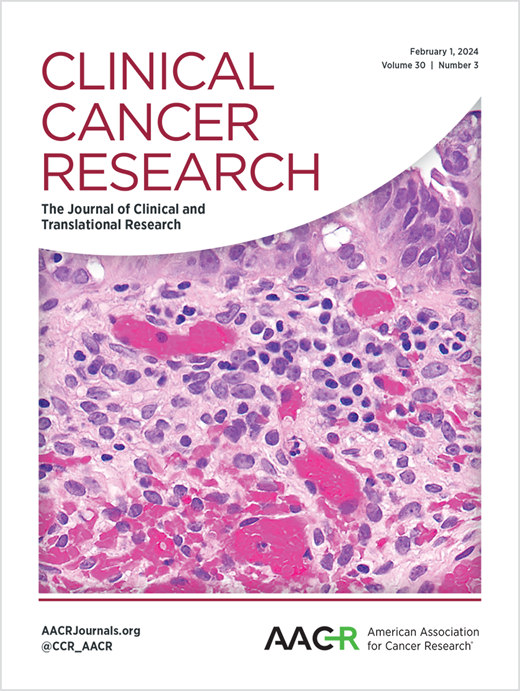First-In-Human Dose-Escalation Study of Fianlimab, an Anti-Lymphocyte Activation Gene-3 Antibody, with Cemiplimab in patients with advanced malignancies.
IF 10
1区 医学
Q1 ONCOLOGY
引用次数: 0
Abstract
PURPOSE Preclinical data indicate that fianlimab (anti-lymphocyte activation gene-3) plus cemiplimab (anti-programmed cell death-1) enhances antitumor activity. Here, we report prespecified final analyses of the dose-escalation part of a first-in-human, phase 1 study (NCT03005782) of fianlimab as monotherapy and in combination with cemiplimab in patients with advanced malignancies. EXPERIMENTAL DESIGN Adult patients received fianlimab 1-40 mg/kg ± cemiplimab 350 mg every 3 weeks (Q3W) across various dose-escalation schedules. Primary objectives were rate of dose-limiting toxicities, adverse events (including immune-mediated), deaths, laboratory abnormalities, and pharmacokinetics. Secondary outcomes were objective response rate, best overall response, duration of response, and antidrug antibody variables. RESULTS Seventy-eight patients were enrolled (fianlimab + cemiplimab, n = 47; fianlimab monotherapy, n = 31). One patient treated with 3 mg/kg fianlimab + cemiplimab experienced dose-limiting toxicities, including increased blood creatine phosphokinase and myasthenic syndrome. No maximum tolerated dose was reached. Any-grade treatment-emergent adverse events occurred in 90% of patients with fianlimab monotherapy, 87% with fianlimab + cemiplimab, and 87% who transitioned from monotherapy to combination therapy. Fianlimab pharmacokinetics were dose-proportional, and similar in monotherapy and combination therapy. Across patients who received fianlimab + cemiplimab, five achieved a partial response; three of whom experienced a response after transitioning from monotherapy to combination therapy. Fianlimab 1600 mg Q3W (20 mg/kg in an 80 kg individual) is the selected dose for phase 2 and 3 studies. CONCLUSIONS Fianlimab as monotherapy and in combination with cemiplimab demonstrated acceptable safety and preliminary antitumor activity, which is generally consistent with previous reports of cemiplimab.晚期恶性肿瘤患者抗淋巴细胞活化基因-3 抗体 Fianlimab 与 Cemiplimab 的首次人体剂量放大研究。
目的临床前数据表明,fianlimab(抗淋巴细胞活化基因-3)联合cemiplimab(抗程序性细胞死亡-1)可增强抗肿瘤活性。在此,我们报告了一项首次人体1期研究(NCT03005782)中剂量递增部分的预设最终分析结果,该研究对晚期恶性肿瘤患者进行了fianlimab单药治疗和与cemiplimab联合治疗。主要目标是剂量限制性毒性反应率、不良事件(包括免疫介导的)、死亡、实验室异常和药代动力学。次要结果为客观反应率、最佳总体反应、反应持续时间和抗药抗体变量。结果共有 78 名患者入组(fianlimab + cemiplimab,n = 47;fianlimab 单药治疗,n = 31)。一名接受3 mg/kg fianlimab + cemiplimab治疗的患者出现了剂量限制性毒性反应,包括血肌酸磷酸激酶升高和肌无力综合征。没有达到最大耐受剂量。90%的菲安利单抗单药治疗患者、87%的菲安利单抗+赛米普利单抗治疗患者以及87%的从单药治疗转为联合治疗的患者出现了任何级别的治疗突发不良事件。菲安利单抗的药代动力学与剂量成正比,单药治疗和联合治疗的药代动力学相似。在接受菲安利单抗+赛米普利单抗治疗的患者中,有5人获得了部分应答;其中3人在从单一疗法过渡到联合疗法后获得了应答。结论菲安利单抗作为单药治疗和与赛米普利单抗联合治疗显示出了可接受的安全性和初步抗肿瘤活性,这与之前关于赛米普利单抗的报道基本一致。
本文章由计算机程序翻译,如有差异,请以英文原文为准。
求助全文
约1分钟内获得全文
求助全文
来源期刊

Clinical Cancer Research
医学-肿瘤学
CiteScore
20.10
自引率
1.70%
发文量
1207
审稿时长
2.1 months
期刊介绍:
Clinical Cancer Research is a journal focusing on groundbreaking research in cancer, specifically in the areas where the laboratory and the clinic intersect. Our primary interest lies in clinical trials that investigate novel treatments, accompanied by research on pharmacology, molecular alterations, and biomarkers that can predict response or resistance to these treatments. Furthermore, we prioritize laboratory and animal studies that explore new drugs and targeted agents with the potential to advance to clinical trials. We also encourage research on targetable mechanisms of cancer development, progression, and metastasis.
 求助内容:
求助内容: 应助结果提醒方式:
应助结果提醒方式:


